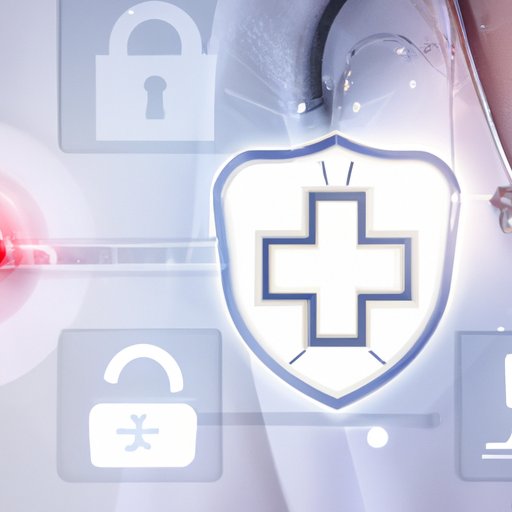Introduction
Data breaches in the healthcare industry are a serious issue that can cause financial, reputational, and legal damage to healthcare organizations. According to the Ponemon Institute’s 2019 Cost of a Data Breach Report, “the average total cost of a data breach for the healthcare industry was $6.45 million.” Cybersecurity is essential for safeguarding healthcare organizations from data breaches and protecting the sensitive information of patients.
A data breach occurs when private and confidential information is accessed without authorization. Cybersecurity protects this data from getting into the wrong hands. It involves the implementation of a range of technological solutions, such as encryption and access control, to protect networks and systems from malicious attack.
Potential Consequences of a Healthcare Security Breach
The consequences of a healthcare security breach can be devastating. These include:
Identity Theft
Healthcare organizations store vast amounts of personal information about their patients on their systems, including names, addresses, dates of birth, Social Security numbers, and credit card numbers. If this data falls into the wrong hands, it can be used to commit identity theft. According to a study by Javelin Strategy & Research, “16.7 million U.S. consumers were victims of identity fraud in 2017, an 8% increase from 2016.”
Medical Record Tampering
Hackers can also use stolen healthcare data to tamper with medical records. This could lead to inaccurate diagnoses and incorrect treatments being administered, which could have serious implications for patient safety. According to a survey conducted by the American College of Cardiology, “nearly half (49%) of cardiologists reported that their practice or hospital had experienced a security breach in the past year.”

New Technologies Enhancing Security in the Healthcare Sector
Innovative technologies are being developed to enhance cybersecurity in the healthcare sector. These include:
IoT
The Internet of Things (IoT) refers to the network of physical devices, sensors, and other items embedded with software, electronics, and other technologies for the purpose of collecting and exchanging data. IoT can be used to improve cybersecurity in healthcare organizations by monitoring user activity and alerting administrators to any suspicious activity.
AI and Machine Learning
Artificial intelligence (AI) and machine learning can be used to detect and respond to cyber threats in real-time. AI-powered tools can analyze large volumes of data quickly and accurately, enabling them to identify patterns and anomalies that could indicate the presence of a threat.
Establishing Secure Communication Protocols
Secure communication protocols must be established between healthcare providers and patients to protect confidential information. This includes implementing authentication and authorization measures to ensure only authorized personnel have access to private patient data.
Between Healthcare Providers and Patients
Healthcare providers should use secure communication channels, such as encrypted emails, to communicate with patients. They should also provide patients with clear instructions on how to securely transmit their personal information.
Authentication & Authorization Measures to Protect Private Patient Data
Healthcare organizations should employ authentication and authorization measures, such as two-factor authentication and role-based access control, to ensure only authorized personnel have access to private patient data. They should also regularly review access rights and revoke access where necessary.
Federal Regulations & Industry Standards
Healthcare organizations must adhere to federal regulations and industry standards, such as the Health Insurance Portability and Accountability Act (HIPAA), to protect the privacy and security of patient data.
What They Are
HIPAA is a federal law that establishes national standards for the protection of electronic health information. It sets out requirements for healthcare organizations to safeguard the confidentiality and integrity of patient data.
Adhering to Them
Healthcare organizations must adhere to HIPAA and other applicable regulations and standards. They should also review their security policies regularly to ensure they are up-to-date and compliant with the latest regulations.
Examples of Successful Healthcare Breaches & How They Could Have Been Prevented
There have been numerous examples of successful healthcare breaches in recent years. In many cases, these breaches could have been prevented if the organization had implemented adequate security measures. For example, in 2017, Anthem Inc. suffered a data breach that exposed the sensitive information of 78.8 million customers. The breach was caused by a vulnerability in the organization’s IT system, which could have been prevented if the organization had implemented robust authentication and authorization measures.
Conclusion
Cybersecurity is of the utmost importance in the healthcare industry. Without it, healthcare organizations are vulnerable to data breaches, which can cause financial, reputational, and legal damage. By implementing innovative technologies, establishing secure communication protocols, and adhering to federal regulations and industry standards, healthcare organizations can protect themselves from cyber threats and keep their patients’ data safe.
(Note: Is this article not meeting your expectations? Do you have knowledge or insights to share? Unlock new opportunities and expand your reach by joining our authors team. Click Registration to join us and share your expertise with our readers.)
